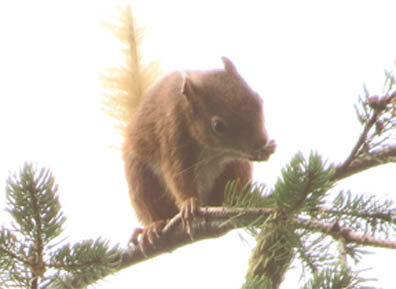| Wildlife
Newsletter for the Township of Dalkey October / 2016 - Michael Ryan |
|

|
Porpoises
aren’t uncommon around Dalkey and Killiney’s coast. Harbour
porpoises are small and dark with a small triangular shaped dorsal fin
and it’s only this fin and a small section of their head and back
that you ever see when they break the surface, they don’t make
spectacular leaps out of the water like their more glamorous relatives
the dolphins and whales. Sometimes the porpoise appear around the same
area of water where gulls and gannets might be clamouring indicating
the presence of a shoal of fish but often enough they’d just be
swimming by and when they dive you can try and guess where they’re
going to appear next, whether they’re circling or moving in a
definite direction. I’d been looking down over the Vico at a small
pod of porpoise very close to shore. The sea was very calm with sunlight
glittering off the surface and every time a porpoise would break the
surface it would send out arcs of gentle ripples. I spent a relaxing
few minutes watching them before continuing my walk. I turned around
hoping to get a final glance of one and that happened to be the moment
a dolphin soared up clear out of the water, twisting mid-air before
splashing back into the sea again. I had read that dolphins were being
seen again around Dalkey but apart from one occasion hadn’t personally
seen any since the pod of three bottlenose dolphins were a daily sight
in Killiney Bay four and five years ago. That one occasion we had seen
dolphins since then was two years ago when a pod of four Rissos Dolphins
briefly appeared in Killiney Bay but Rissos are more uncommon and don’t
do spectacular breaches like the one I have seen so it was most likely
a Bottlenose Dolphin. Naturally surprised and delighted to see it but
further surprised that it was sharing the same space of water with porpoise.
Dolphins are much bigger than porpoise and can often get very aggressive
with them to the extent that the death of a number of porpoise found
washed up has been attributed to them being battered and bitten to death
by dolphins and quite a few people have witnessed, photographed or filmed
quite disturbing footage of dolphins actually killing porpoise. Hopefully
the dolphin and porpoise here were well disposed towards each other. Have seen porpoise many times since but not a sign of dolphins which makes that brief spectacular view even more precious. |
|
HOPE SPRINGS IN AUTUMN |
| DALKEY TERN PROJECT Over the winter the Council employed a pest control operative who removed a large number of rats from Dalkey Island. Initially the terns had what looked like what was going to be a good year with over 70 pairs of Arctic terns nesting on Lamb Island (the western part of the island separated at high tide) producing dozens of chicks but tragically over the course of one weekend all the newly born birds disappeared. Birdwatch had employed a temporary warden for the project but he wasn’t on duty the weekend the birds disappeared so nobody knows how they died, whether the parent birds were initially disturbed by people (which I suspect, especially since it happened on a weekend) and then deserted the chicks who were predated on by rats or gulls or whether some other dismal fate had befallen them. The only positive outcome was the return of a pair of Roseate Terns to nest in a box on Maiden’s Rock and though they had left it too late in the season to successfully rear young the fact they returned there at all is encouraging for the future. |